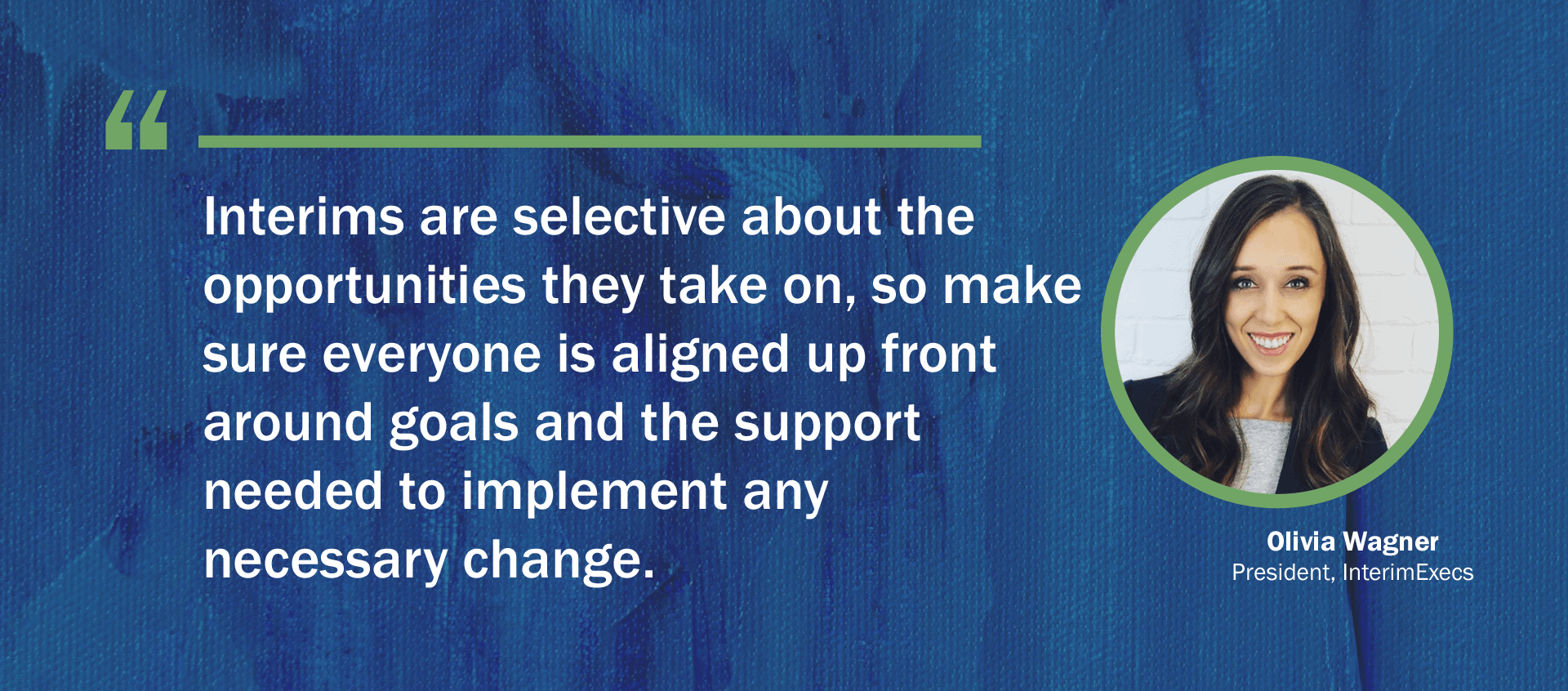How to Prepare Your Company and Team for an Interim Leader

Your Complete Guide to Interim Management — Chapter 8: How to Prepare Your Company and Team for an Interim Leader
07: How to Prepare Your Company and Team for an Interim Leader
As we have noted throughout this guide, interim executives are a different breed of leader. They are wired for action and will arrive at your organization ready to take charge and make changes. Preparing the company and executive team members for an interim is a critical step in maximizing the value the organization reaps from an interim executive’s leadership.
There are multiple steps:
Identify Your Most Critical Needs
As we have noted, interim executives start any assignment by doing their own assessment of the company’s needs, challenges, and opportunities.
However, the business owner, board, and/or former CEO should have created their own list before engaging an interim. It is imperative for the organization to look critically at its current performance and opportunities to determine a list of needs. It gives the interim fertile ground to start exploring.
Of course, sometimes a C-suite vacancy is unexpected. This can happen due to the sudden departure of a sitting executive, the serious illness of a senior executive or family member, maternity or military leave, or board directives requiring specialization that the company does not possess. To prepare for such an uncertainty, your company’s succession planning strategy should include the potential for short-term senior management.
Agree on the Goals
All new leaders are measured on results, none more so than interim executives. Their temporary status makes measurable results critically important. That means the organization needs to be able to translate its needs into goals. Do that using the SMART approach to create goals that are:
▶ Specific – use action words like develop, design, create, etc.
▶ Measurable – use objective data such as dollars, units, percentages, etc.
▶ Acceptable – gain consensus with all stakeholders of the priority and need for the goal
▶ Realistic – ensure the goal is attainable but challenging
▶ Time-Bound – a specific timeframe must be set
An example of a well-stated goal is “Reduce the cost of goods by 10% for the last six months of this fiscal year.” While this exercise may seem sophomoric, it is surprising how many companies fail to define their goals in a manner that can be shared, validated, measured, and achieved.
For each of the needs defined at least one goal should be developed. Some needs may require several goals from different individuals or departments to satisfy the need. For example, the need to address a product gap in the marketplace may require goals from engineering, marketing, sales, and service.
These goals should be written down and approved by the executive team, CEO, and/or the board. These will be helpful during the recruiting process as they will define the skill set needed for the interim. They will also allow the interim and the company to align on the scope and timing of the assignment.

The Complete Guide to Interim Management
-
- 01 What is an Interim Executive?
- 02 When is an Interim Manager the Right Choice?
- 03 When an Interim Executive is Not a Good Option
- 04 What’s the Difference Between an Interim Executive and a Consultant?
- 05 How do Interim Execs Approach Assignments?
- 06 Interim Executive Recruitment: Making the Right Match
- 07 The Process for Engaging an Interim Executive
- 08 How to Prepare Your Company for an Interim Leader

Set the Parameters
Interims step into their new leadership role focused on results. They will expect to take the reins of the organization and make decisions. They assume the organization is prepared to fund initiatives and move quickly as well.
Defining the parameters of the engagement before recruiting the interim is essential to ensure a good match. Some key questions to answer include:
▶ How much? A budget for the engagement should be prepared. This should include the cost of the interim’s contract as well as budgets for projects the interim will be expected to tackle and incentives for high-performing results.
▶ How often? Periodic review of the interim’s progress is essential. Define the schedule and method for reporting to the CEO or Board.
▶ How much authority? A key to the interim’s effectiveness is their ability and willingness to exercise judgment on many matters without needing to formally ask the Board for permission. Define how much latitude the interim has in changing processes, procedures, and culture without checking in with the board. If the interim will be approving expenditures, investments, or other financial matters, set the parameters for the signing authority.
▶ For what outcome? The company’s strategy for engaging an interim needs to be clearly defined. Perhaps keeping the company moving forward during the search for a new full-time CEO is all that is needed. For some major initiatives, the interim may be asked to recruit new executives and rebuild complete teams. Other engagements may require the interim to raise capital or sell the company. In every case, the scope of the desired outcome should be well-defined and documented so the organization and the Interim are aligned from day one.
Assign an Appropriate Title and Position
This might feel like a superfluous concern when you have so many bigger decisions to make. But, depending on the company’s culture, titles and positions can be critically important to the interim’s success.
The title “Interim CEO,” for example, can be fine if the interim is there to fill the vacancy while the company searches for the new permanent hire. However, it is imperative that the organization’s leaders let the entire team know that the interim is in charge and will be making decisions that must be implemented. In effect, the organization needs to understand that “interim” does not mean “powerless.”
Communicate Unequivocal Support for the Interim Executive
The Board (or the CEO if the interim is a C-level executive) needs to prepare and deliver a compelling case for why an interim executive is being brought in. Successful delivery of this message will provide the organization with an understanding of the framework and context of what to expect during the coming months and serve as a guidepost for the interim.
The argument must lay out specifics on the needs, goals, and parameters of the assignment. It needs to be data-driven, logical, and in line with the vision, mission, and core values of the company.
The rest of the executive leadership team and the entire organization will need to embrace and support what may appear to be a confusing and threatening situation.
Some of the current executives may be looking to be considered for the open position. Decide early on if they will be interviewed for the position. Some may be concerned that their own performance is lacking and will be reviewed by the interim. You must assure them unequivocally that their position is not at risk.
Key employees may also hold back in working with the Interim. They may be skeptical about starting new projects led by a new outsider. There is also the risk of key employees electing to leave and seek an organization where they perceive more certainty.
To head off disrupting rumors, the organization needs to be proactive and manage the news. Typical questions will include the following:
▶ Why an Interim? In addressing this question, the company should be clear on the value it sees in using an interim, sharing supporting points in a consistent manner, such as:
Interim executives are a popular alternative to using a consultant or leaving a position vacant during a search for the right person. Interims are experienced leaders who bring a fresh, unbiased review of the factors driving operational results. An interim does not waste time or company resources trying to secure a full-time job but is driven by the opportunity to make changes that lead to a sustainable value increase for all the stakeholders of the business. We should expect immediate improvement in delivery, quality, and cost across our business units while we search for the right new full-time hire.
▶ Who will report to them? Interims usually have the same direct reports as the outgoing executive unless there is a reason to restructure. One reason for a different reporting structure may be that the previous executive did not have a broad enough skill set and this is an opportunity to expand the role. It may also make sense to reduce the number of subordinates to obtain a tighter focus on some key areas.
Regardless of the situation, the organization must know both interim and future reporting structures. If part of the interim’s role is to evaluate and suggest a future structure, care should be given to explain this in a way that does not create panic in the team.
▶ How to communicate to the staff? Create a message that has a positive spin, with an emphasis on solving problems and expected beneficial outcomes. This message should review the needs, goals, and parameters that led to the decision to bring in an interim. Obviously, in some situations, there will be a need to hold back some sensitive issues until the interim is able to make a clear assessment and review it with the board of directors.
Formal Introduction
This should happen at a meeting of the interim’s direct reports and other key employees. Start the meeting by introducing the interim executive’s new role and reviewing the reasons they were engaged and their key areas of focus.
Then, the interim should be given the floor to present a background overview and answer any questions. Each of the staff members present should also review their functions, years with the company and their backgrounds. This serves as an ice-breaker meeting and initiates an open dialog for the future.
Next, send an announcement to all employees. A typical announcement of an interim in the CEO role might look like this:
Staff,
As you know we are engaged in the search for a new CEO. While we conduct this search we want to continue our progress towards our Mission of (Company Mission.) To ensure we stay on track we have asked (name of interim) to join us as an interim CEO until the new chief executive is on board. In addition to 10 years’ experience in (name the domain) (interim’s name) has a technical degree in (name the field) and has been involved in (startups, turnarounds, acquisition integration, M&A, financing, business development, etc.). Feel free to engage with him at your earliest convenience to see where he may be of help to you.
His responsibilities will include:
1. Working with the executive team to provide guidance and leadership toward our goals and objectives.
2. Identifying new opportunities for growth and profitability.
3. Assisting the recruiting team in the evaluation and selection of the incoming CEO and the CEO transition.
We appreciate your support so far during this CEO change and ask that you work with (interim’s name) to keep the momentum going for our business.
Respectfully,
The Management Team/Board members/etc.
Immediately after sending the message, the new leader should schedule one-on-one meetings with the direct reports for a more detailed discussion to be followed by an introduction to their staff in each department. This will reduce anxiety and give the interim an opportunity to learn first-hand about the team and to answer any questions regarding the assignment.

FREE DOWNLOAD
Top Trends Driving the Growth of Interim Management
▶ 5: How do Interim Execs Approach Assignments?
▶ 6: Interim Executive Recruitment: Making the Right Match
▶ 7: The Process for Engaging an Interim Executive
▶ 8: How to Prepare Your Company for an Interim Leader.

